In this presentation, Gary Klein shares important information about air source heat pump water heaters (HPWH), with particular attention paid to where the warm air comes ...
How to Run a Hot-Water Zone Off a Steam Boiler
Q: Is it possible for me to use the condensate in a steam boiler to make a hot water zone?
A: Sure! Heating professionals have been doing this for years in areas such as New York City where there's still a bodacious amount of steam heat.
Q: Do I need a water-to-water heat exchanger to do this?
A: You could use a water-to-water heat exchanger or the boiler's tankless coil if you'd like, that will give you a first-class installation. However, if you follow a few simple piping rules, you can get the job done without the heat exchanger.
A: You'd set it up much the same way you would any hot water system. The water-to-water heat exchanger would become the "boiler" for your hot water zone.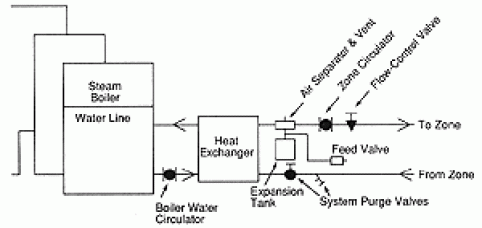
Pressurize the new zone with an automatic feed valve and a properly sized compression tank. Wire the circulator to come on at the call of the room thermostat. Have it pump away from the compression tank and toward the radiation. You'll also need a second circulator to move water from the boiler to the heat exchanger. Wire this one so it runs at the same time as the zone circulator.
Q: Is it absolutely necessary for me to have that second circulator between the boiler and the heat exchanger?
A: The system works best if you do, but you could also let hot boiler water circulate through the heat exchanger purely by gravity. If you do it this way, however, the system's response to a call for heat won't be as fast as it would be if you use the second circulator. That second circulator pays for itself in system performance in no time at all.
Q: Are there any other drawbacks to circulating the boiler water through the heat exchanger strictly by gravity?
A: The main drawbacks is you need full-size tappings in the boiler. The size you need is typically 2" and the trouble is most modern steam boilers don't give you many extra tappings, let alone 2" ones.
Q: What happens if I use a smaller boiler tapping?
A: The resistance to flow through the heat exchanger will be greater so less hot boiler water will flow through the heat exchanger. Less flow means less heat transfer. You may not be able to get enough heat up to that new zone.
Q: Who manufacturers a good heat exchanger for this purpose?
A: Everhot (191 Arlington Street, Watertown MA 02172) makes one which I've seen work well on many jobs. Their unit is very similar to the old tank-type heaters from the Steam Era.
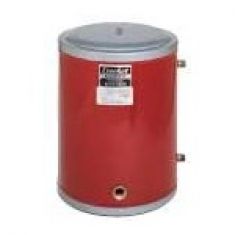
The Everhot Model RH-8 will handle a hot water radiation load of about 45,000 Btu, which is more than you can expect to deliver through a 3/4" line to a hot water zone.
Q: Does the heated water going out to the zone flow through the coil or through the tank?
A: The zone water goes through the coil. The boiler water flows through the tank.
Q: Does the hot water radiation have to be lower than the steam boiler's water line?
A: No. If you're using a heat exchanger, your compression tank will keep the system under pressure. The fill pressure and tank size determine how high you can place the radiation above the boiler's water line. The only limit is the working pressure of the equipment you're using. It takes 1 psig water pressure to raise water 2.31 feet straight up. So, if you have equipment rated for, say, 100 psig, you'll be able to lift water about 230 feet to a hot water zone - if you ever wanted to (I don't think you'd ever want to, do you?). Let me put it another way - that two- or three-story house won't be a problem.
Q: Suppose I decide I don't want to use a heat exchanger, will my radiation have to be lower than the steam boiler's water line?
A: No, if you use 3/4" supply and return piping, and make sure you don't use any air vents whatsoever in the zone piping , the radiation can be as high as 30 feet above the steam boiler's water line.
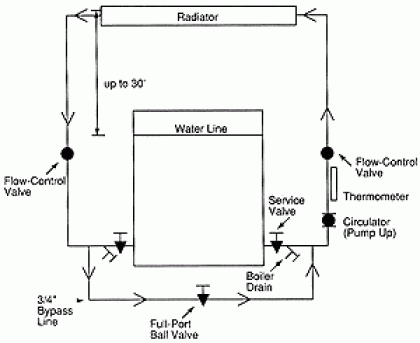
Q: What keeps the water up there in the zone piping if there's no automatic fill valve or compression tank?
A: Atmospheric pressure. It's the same phenomenon which keeps water in a straw when you put your finger over the top end and lift it out of a glass of water.
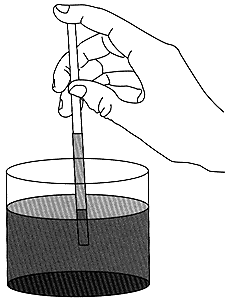
The water tries to fall out of the straw, but the atmospheric pressure (the weight of the air) pushes it back up. Since no air pressure can get into the top of the straw to balance the air pressure at the bottom of the straw, the water just hangs there.
Q: But a 3/4" pipe is wider than a straw. Won't the water fall out of it?
A: Not unless air gets up into the zone. The principle is the same, regardless of the width of the pipe. At sea level, the atmosphere pushes down on everything with a pressure of 14.7 pounds per square inch. One pound per square inch can lift water 2.31 feet straight up, so, if you have a pipe that's sealed at the top and completely filled with water, the atmospheric pressure will be able to support a column of water about 34 feet high (14.7 psia X 2.31 feet = 33.957). It has to do with pressure, not the width of the pipe. Get it?
Q: I'm not sure. Can you give me another example?
A: Here, think about this. Suppose you were to lift an upended glass out of a bucket of water.
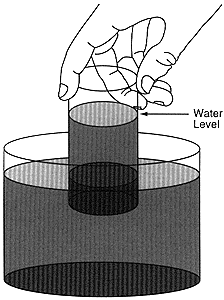
The water stays in the glass because the atmospheric pressure pushes it up there. The glass is certainly wider than a straw, but since air can't get into the top of the glass to offset the pressure at the bottom, the water stays where it is. For practical purposes in your hot water zone, you can raise water 30 feet (or about three stories) and make it stay up there.
Q: Suppose I live in Denver, Colorado? Will this still work?
A: Yes, you just won't be able to keep the water up as high because the atmospheric pressure is less in Denver than it is in, say, New York City. The atmospheric pressure in Denver is about 12 psi. One psi still lifts water 2.31 feet, so let's see...12 psi X 2.31' = 27.72. In Denver, your zone could be, say, 25 feet above the boiler water line. That's enough to get you up to the second floor of a house with no problem at all. Going to the third would be cutting it close.
Q: But I can't use any air vents at the top of the zone, no matter where I live, right?
A: Right, an air vent will let air into the top of the system. Once that happens, the water will fall back into the steam boiler.
Q: Does this apply to manual air vents as well as automatic air vents?
A: Yes, it does. You want to have the tightest possible connections you can get above that steam boiler's water line. For this reason, you should also avoid using any valves with packing glands. They, too, can draw air into the system and cause the water to fall out of the zone. Just solder the joints tightly and let it go at that.
Q: So how can I fill the zone with water if I can't vent the top?
A: Set it up as a loop system and fill it with a garden hose.
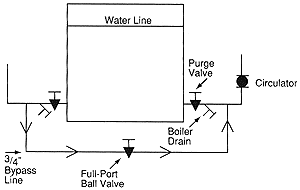
Pipe in two ball valves (or gate valves) and two boiler drains below the boiler water line. Shut both ball valves (or gate valves). Now connect the garden hose to one of the boiler drains and let the other flow freely to a drain. Fill the zone piping under city water pressure until all the air comes out. Then, shut off the discharge boiler drain and the inlet boiler drain (in that order). Now open the two ball valves (or gate valves). If you did a good job of soldering, the atmospheric pressure will keep the water up in the zone.
Q: Are you sure of that?
A: Yes! Let's go over that basic principle one more time.
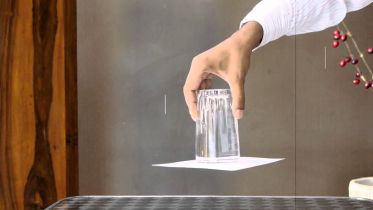
The water stays in the glass because the atmospheric pressure pushes it up there. The glass is certainly wider than a straw, but since air can't get into the top of the glass to offset the pressure at the bottom, the water stays where it is. For practical purposes in your hot water zone, you can raise water 30 feet (or about three stories) and make it stay up there.
Q: If I'm not using a heat exchanger with a compression tank will there be any pressure on the water that's in the zone?
A: There won't be any pressure at the top of the system. There will, however, be pressure on the water further down in the zone.
Q: Where does this pressure come from?
A: This is the static pressure we talked about before. It comes from the weight of the water. The higher the column of water, the greater the static pressure at the bottom will be.
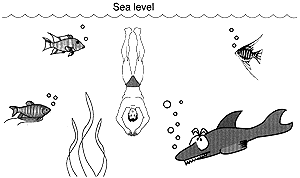
Want another example of static pressure? Think of the water in the ocean. There's no pressure at sea level, but as you dive deeper and deeper, the pressure increases because there's more water sitting on top of you. In our zone, "sea level" is the high point.

Q: How hot will the water in my steam boiler usually be?
A: It depends on the steam pressure. The boiling point of water increases as the pressure on top of the water increases. For instance, if your steam boiler operates at 2 psig pressure, the water in the boiler will boil at 219 degrees F. If you run the boiler pressure up to 5 psig, the water won't turn to steam until the temperature reaches 227 degrees F. At atmospheric pressure (which is what you have at the top of the system), water boils at 212 degrees F.
Q: How does this affect the operation of my hot water zone?
A: If you're not using a heat exchanger and a compression tank, the water at the top of your zone can boil if it gets too hot.
Q: Will this be a problem?
A: It sure will! When water boils, it "flashes" into steam and increases in volume about 1,700 times. It does this instantly and, in a sealed "container" such as a piping system, with great violence. "Flash" steam is potentially very dangerous. It could actually blow soldered joints apart.
Q: When is this likely to happen in my hot water zone?
A: When the zone circulator shuts off.
Q: How come?
A: The water usually can't flash to steam when the circulator is on because the circulator adds a certain amount of pressure to the water. That extra pressure can keep the water in the liquid state. However, when the circulator shuts off, its pressure disappears and that's when the water at the top of the zone can flash into steam.
Q: Can this happen if the zone is lower than the boiler water line?
A: It's possible, but it's not likely because the higher water level in the boiler puts a certain amount of static pressure on the zone.
Q: Well then, how can I make sure the water at the top of the top of my system never flashes into steam?
A: By making sure the water entering the zone never approaches 212 degrees F. The simplest way to do this is to blend a portion of the water that's already been through the zone with the hot supply water leaving the boiler.
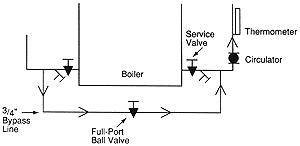
Q: Do I need special valves to do the mixing?
A: Not at all. All you need is a 3/4" copper line between the zone return and the inlet side of the circulator, a 3/4", full-port ball valve and a thermometer. Pipe the ball valve into the bypass line and leave it fully open when you first fire the steam boiler. Next, let the boiler come up to steam pressure, and then start your circulator. With the bypass ball valve fully open, nearly all the water in the zone will bypass the boiler because it's easier to go through the bypass than it is to go through the boiler. That's the path of least resistance. Now, to make the water flowing into the zone hotter, all you have to do is throttle the bypass ball valve a bit. Keep you eye on the thermometer as you do this. You'll see the temperature rise very quickly.
Q: Why does the temperature go up?
A: When you throttle the bypass ball valve, some of the returning water finds it easier to flow through the boiler than it does to go around the bypass.
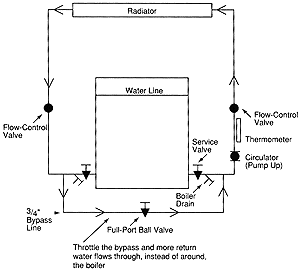
When this hot water comes out on the other side, it mixes with the water that bypassed the boiler and gives you a mix that's hotter than the return water, but cooler than the boiler water.
Q: How much water should I let through the boiler?
A: The flow in gallons per minute isn't crucial here. Just keep your eye on the thermometer on the line supplying the zone. Stop blending when it reaches 180 degrees F. Then, take the handle off the ball valve so no one else can mess with it. This will be the hottest water the zone will ever see.
Q: So as long as the supply water going up to my hot water zone never reaches the boiling point, it can never flash into steam?
A: That's right. You've set a fixed limit on the temperature by mixing the return water into the supply water while the boiler was making steam at its pre-set pressure.
Q: Is there anything that can change that temperature?
A: Well, if someone raised the steam boiler's pressure the water temperature in the boiler would also go up. But by setting the blended water temperature at 180 degrees F, you've left yourself a comfortable margin of safety.
Q: Does it matter whether the circulator pumps away from the boiler or toward the boiler?
A: It's better to pump away from the boiler.
Q: How come?
A: Since this isn't a pressurized system, there's always the possibility the water can flash to vapor inside the circulator if the pressure drops too low when the circulator comes on. Technically, this is called "cavitation" and it can destroy a circulator in no time at all.
Q: Why does the pressure drop when the circulator comes on?
A: Because the circulator throws out what's inside of itself. This causes an immediate drop in pressure at its suction. This centrifugal action is what makes the water flow into the circulator in the first place. The trouble starts when there's not enough pressure behind the water flowing into the circulator to keep it in a liquid state.
Q: So the circulator itself can change the boiling point of the system water?
A: In effect, yes. It can change the boiling point of the water that's entering the circulator. And keep in mind, you don't have much pressure to work with on these jobs - just the height of the water in the boiler above the circulator. And then there's the pressure drop of the piping between the boiler and the circulator to consider. If you start off with a limited static pressure (the height of the water in the boiler) and then lose a portion of it to friction in the approach piping, it may be difficult to control things. That's' why it's best to pump away from the boiler. By keeping the circulator close to the source of the pressure (the water in the boiler), you lessen your chances of having problems.
Q: Does this apply to one case more than another?
A: It's especially important for those zones where you have all the radiation and piping below the boiler water line. If you have the circulator on the return, the pressure drop through the piping can cause the boiling point to drop. Combine this with a high starting temperature (which you'd have if the steam pressure were high and if you decided not to use that bypass blending valve) and you're asking for trouble. In the case where you have the zone radiation and piping above the water line, the circulator location isn't as critical because you have the static pressure of the water in the zone working in your favor. It's good to get into the habit of putting the circulator on the discharge side of the boiler, though. That way, you'll always be in good shape, whether you're piping a condensate zone, or any hot-water zone. Circulators always work best when they're "pumping away."
Q: Where should I pick up my supply tapping?
A: That will vary from boiler to boiler. Modern steam boilers don't have very many extra tappings. You always want to pick up tappings that are lower than the boiler's water line, of course. And remember to keep your circulator as low as possible to take advantage of the static weight of the water in the boiler. If you have a blank tankless coil plate, you could drill and tap it for a 3/4" supply. That works well.
Q: Could I use the steam boiler's lower gauge glass tapping?
A: No! If you pump water through this connection you'll never know where the water line in the boiler is. You'll also affect the low-water cutoff if it's hooked into the gauge glass on quick hook-up fittings.
Q: How about on the return side of the zone piping. Where does that tapping go?
A: Again, use any available boiler tapping below the water line (never return water above the water line). If you can't find a return tapping, return into the system system's wet return, near the boiler.
Q: Does it matter which side of the Hartford Loop I tap into?
A: No, either side is fine, just keep that return tapping below the boiler's water line.
Q: Can I supply and return from the same side of the boiler?
A: You shouldn't enter and leave though the same section because the zone water might not have enough time in the boiler to pick up the necessary heat. Ideally, you should pipe from opposite sides in a diagonal pattern. Like this.
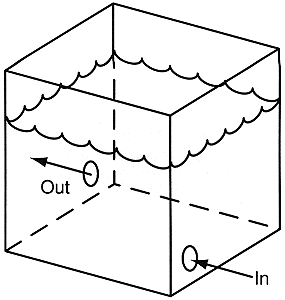
Q: Can I pipe straight through the boiler's mud leg?
A: No, because the water will zip through the boiler too quickly. It won't pick up enough heat, and you'll have a call-back for sure.
Q: Suppose there's no way I can tap directly into the boiler. Does that mean I can't zone with condensate?
A: You can still do it, but you have to use a bit of creativity. Here, just follow this diagram.
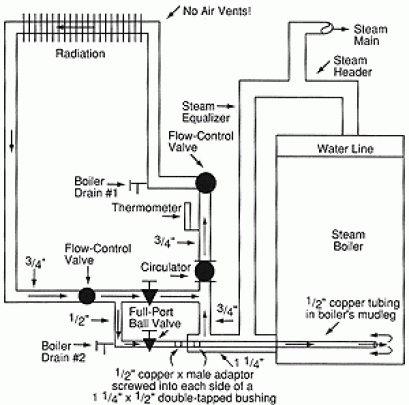
Since you can't tap directly into the boiler, you'll use the 1-1/4" tee at the bottom of the steam equalizer line as both a supply and return point. Take a 1-1/4" X 3/4" tee and screw a 1-1/4" X 1/2", double-tap bushing into it. Next, solder a length of 1/2" copper tubing to a C X M adapter and screw that into the boiler side of the bushing. Now, screw another C X M adapter to the other side of the bushing. That's your return tapping. The copper tubing reaches deep into the boiler's mud leg and deposits the cooler return water on the side opposite the one from which you'll be drawing your hot supply water. You'll take the hot supply from the bull of the tee. By doing it this way, you'll get the circulation you need across the boiler to pick up the heat for the zone.
Q: Do I still need a bypass line if I pipe it this way?
A: Yes, the bypass allows you to temper the water as it leaves the boiler. The bypass keeps the water from flashing steam when the circulator shuts off.
Q: How do I start this one up?
A: Fill the zone with water by using the two boiler drains. Put a hose on #1 and purge back through #2. Let the boiler steam, and then start the circulator. Use your two ball valves to blend the water through the bypass until your supply temperature reaches 180 degrees F. Take the handles off the ball valves and you're all set.
Q: Before, you said I shouldn't pipe directly through the boiler's mud leg because I wouldn't pick up enough heat on each pass. Does that happen with this system?
A: No, it doesn't because the copper tubing injects the water deeply into the boiler and forces it to reverse direction before it can leave the boiler. This action makes the return water at the bottom of the boiler very turbulent. It mixes things up, allowing you to pick up the heat you need for that zone.
Q: With any of these systems, should I put a strainer on the inlet side of the circulator so I don't suck mud out of the boiler and into the circulator?
A: No, because the strainer can produce a very large pressure drop at the circulator's inlet, especially when it gets dirty. That drop in pressure can make the circulator cavitate.
Q: Well, what's to keep the circulator from clogging up then?
A: If you choose the right circulator for this application you won't have a problem. I like to use a 1,750 rpm three-piece circulator for these zones because they have larger and wider impellers than their smaller, high-speed, wet-rotor cousins. A larger circulator fares better on this application because it can pass more debris through its impeller.
Q: Should I use an iron-body circulator?
A: You could, but a bronze circulator will last much longer here. Condensate usually has a good deal of carbonic acid mixed in with it. Bronze is a much better material than iron for this service.
Q: How should I control the zone?
A: The simplest way is to use a room thermostat to operate the circulator through a double-pole, single-throw relay such as Honeywell's R845A. You'll also need a single-pole, single-throw, immersion-type aquastat (such as Honeywell's L4006A) to set the maximum boiler temperature when you're not making steam. Wire the controls so the circulator and the burner come on at the same time. The burner will bring the boiler water up to 180 degrees F and no higher. The aquastat sees to that. It will shut the burner off, but the relay will keep the circulator running as long as the room thermostat continues to call. By setting it up this way, you're able to supply hot water to the zone without making steam. As far as the folks upstairs are concerned, the steam system and the hot water zone are totally independent.
Q: What if the steam system just shut off and suddenly the hot-water zone comes on. What happens then?
A: The boiler water temperature will be higher than the 180-degree F of the aquastat so the zone thermostat (working through the relay) will start the circulator, but not fire the burner. Simple, isn't it?
Q: Could I pipe an indirect domestic water heater off a steam boiler using the same piping techniques I would with a heating zone?
A: Yes. Just treat the indirect heater as you would a radiator. Make sure you blend return water into the hot boiler water to limit the supply to the heater to 180 degrees F Here's a sketch.
Q: How many hot water zones or indirect heaters can I take off a steam boiler?
A: That depends on the boiler's capacity. You can't take out more BTUs than you put in. I've seen people try to add one too many hot water zones and when it came time to make steam, they were out of luck.
Q: What's a practical limit for a house?
A: Again, a lot depends on the size of the boiler. Usually, you can get away with a 3/4" line, flowing about 4 gpm. That'll deliver 40,000 BTUH, or so to the zone. That's enough to heat a good size zone.
Q: Will I always be able to get 40,000 Btu/hr our of a residential boiler?
A: Yes, if the boiler's net load is over 120,000 Btu/hr.
Q: How come?
A: Because you're playing with the boiler's pick-up factor. The pick-up load usually represents about a third of the net load, depending, of course, on how the installer sized the steam boiler. One-third of 120,000 Btu/hr is 40,000 Btu/hr. That's equal to 4 gpm, about what you can expect to flow through a 3/4" copper line.
Q: What is the purpose of the pick-up load?
A: The pick-up load gives you the "extra" capacity the boiler needs to heat the pipes as the steam heads out toward the radiators.
Q: Is the pick-up load always available to me?
A: No, it becomes available to your hot water zone only after the steam pipes have heated up.
Q: How about if I'm not making steam?
A: If you're not making steam, the pick-up load (and the rest of the boiler load) is obviously available to your hot water zone.
Q: So the pick-up load sets the limit on what I can do with this zone?
A: Yes.
Q: Let's say I'm sizing a new steam boiler and I want to use one or two hot water zones. Should I add the Btu/hr of the hot water zone into the Btu/hr load I need for the steam system and then select a boiler for the combined total?
A: No! Never add the hot-water-zone load to the steam load when you're sizing a replacement steam boiler. This is a game of subtraction, not addition. Size the steam boiler first. Base it on the connected steam radiation load, plus a suitable pick-up factor, not the heat loss of the building. Then work with the available pick-up load to size your hot water zone or zones. You can't take out more than what's there.
Q: What happens if I over-size my steam boiler?
A: You'll have problem with the steam side of the system: surging water lines, water hammer, uneven heat, high fuel bills.
Q: Could I wire the boiler for priority. You know, either make steam or run the hot water zones, but not both at the same time?
A: Yes, but this limits the usefulness of the hot water zones. Suppose you want some heat but you can't get it because the steam zone is calling? Or vice versa.
Leave a comment
Related Posts
This all-technical, three-hour seminar will make you familiar with the many types of old steam heating systems and what goes wrong with them. Dan Holohan’s easy-to-follow...

In this all-technical three-hour seminar, Dan Holohan will give you a Liberal Arts education in those Classic Hydronics systems. He’ll have you seeing inside the pipes as...